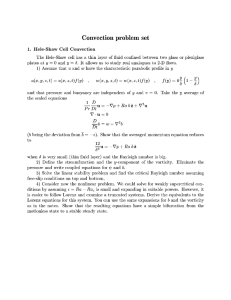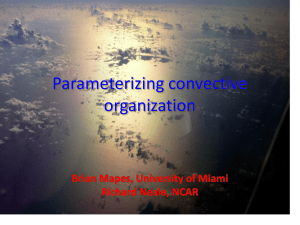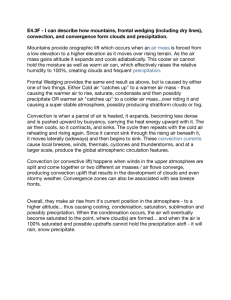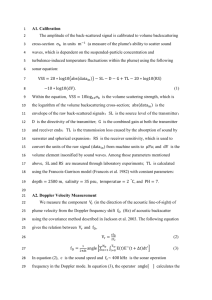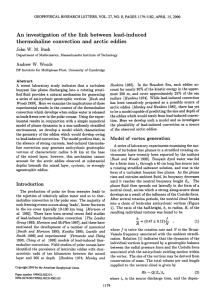pptx - University of Miami
advertisement
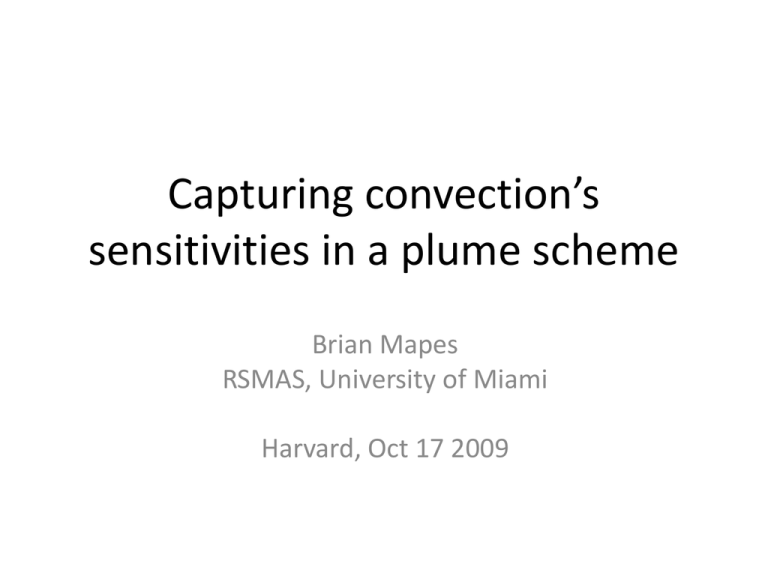
Capturing convection’s
sensitivities in a plume scheme
Brian Mapes
RSMAS, University of Miami
Harvard, Oct 17 2009
(personal) historical moment
• Two very old ideas, fiiinally coming to fruition?
1. 1995: study convection sensitivities
– inhibition vs. bulk instability (CAPE) controls
– sensitivities at equilibrium (as opposed to hotbubble triggered storms)
• 1997: learned cloud model (Clark-Hall)
– Hated the technical side (scripts and queues and
mass stores, oh my!)
– Methodology new -- “parameterized large-scale
dynamics,” not just LS “forcing” – but feeble
– Salvage writeup in 2004
– Proposed mo better with Stefan
• RESULTS IN PRESS just last week
• w/in days of Zhiming’s very complementary work
• A rich suite of important sensitivities to guide
parameterization is in hand!
T&M 2009 and Kuang 2009
• Want Q’ = { Q1’(p), Q2’(p) } as functions of
thermo. sounding anoms S = { T’(p), qv’(p) }
• Method 1: direct, but from, not in eqm.
– stimulus response: create S’, watch Q’(t)
– ensemble for stat. robustness (48 in T&M)
• Method 2: inverse: uses (requires) linearity
– S’ = F Q’ , Q’ perturbed via forcing: in equilibrium
– time is the statistical dimension: sustain Q’
– Magical multilinearity: Q’ = F-1 S’
– S’(t) = S’(0) exp(F-1t) can be compared to Method 1
Responses to midlevel T’
Method 1:
stimulus and
response
ensemble mean
(T&M 2009)
Method 2:
Matrix inversion
from long
maintained
forcing
perturbations
(Kuang 2009)
Responses to low level T’
Method 1:
stimulus and
response
ensemble mean
(T&M 2009)
Method 2:
Matrix inversion
from long
maintained
forcing
perturbations
(Kuang 2009)
(personal) historical moment
• Two very old ideas: 2
• Parameterization idea from Y2K in Hawaii
– Trying to devise buoyancy calcs for lifted air
(w/mixing etc. – thanks Dave R for codes) that can
explain congestus clouds in obs. soundings
– Impossible with usual entrainment treatments!
• lower trop buoyancy weak – dilution kills it
• upper trop buoyancy strong – hard to stop plume at
midlevels without a lot of mixing
– deny latent heat of freezing? maybe... sorta hokey though
Simple (constant) entrainment
COARE mean sounding:
The buoyancy of an air
parcel starting from the
boundary layer is reduced
by entrainment of ambient
unsaturated air.
Arakawa and Schubert 1974
Tropical west Pacific
mean sounding
An Idea
• cloud fields are organized.
• Congestus may happen by entraining
previous/ neighbor clouds as a low level
boost, THEN starting to dilute with “env” to
lose buoyancy at midlevels.
Contention:
The taller clouds aren’t subject to less mixing,
they just have a positional advantage
Yes to entrainment, but sometimes of
non-average air
Discretize plume ensemble by generations
rather than by a priori entrainment rates
3
2
1
1
2
1
1
• All plumes entrain strongly. First clouds entrain clear air, so they
provide needed sensitivity to qv, but are typically shallow.
• Later convection may entrain air pre-moistened by prior clouds.
• This gives deep clouds an indirect q dependence, but opens up
questions of cloud-field organization.
This slide is about 10 years old! (Y2k)
Progress (decadal)
• Key sticking points passed this year
– Steady state assumption
• everything is a mass flux
– no ‘area’ or ‘mass’ or ‘time’ to confuse me
– just plumbing: plug detrainment from plume i into ent i+1
– Picked up a specific, published, closed, GCM
implemented entraining-detraining plume
(Bretherton et al. 2004; Park&Breth 2009)
assumption: rad!
• “Unbiased”, if not locally accurate
• Game-changer for tractability
– prognosis = what arrays to define & carry in memory
across time, how to decommission memory objects,
how to conserve variables (open sys) -- ???
– steady plume: conserve mass, mse, qtot, integrating
upward to solve a timeless function of height
• D/Dt w d/dz
Park, S., and C.S. Bretherton, 2009: The University of Washington
Shallow Convection and Moist Turbulence Schemes and Their
Impact on Climate Simulations with the Community Atmosphere
Model. J. Climate, 22, 3449–3469.
Details aside (til Seattle next week)
– I just wrap a loop around the plume computation,
and pass plume i’s detrainment (mass flux and
thermo. properties) into the in-box for mixing for
plume i+1
– After 1st plume, closure hinges on plume-plume
interaction probabilites (overlap, or organization).
‘Organization’
Org = 1
Org = 0
big
org
0 < org < 1
Effects of organization (= overlap)
in a given sounding with fixed assumptions
• Have M(p), w(p), so width(p) = (M/rw)1/2
org = 0.1
org=0.5
Effects of organization (= overlap)
in a given sounding with fixed assumptions
org = 0.1
org=0.5
Back to sensitivities: constrain plumes?
3K/d
~75% of mean Q for 0.5K pert
~ 150% of mean Q for 1K pert
Translation: 100% mass flux increase for 1K
buoyancy feature: 1/M dM/dp = 1 x dB/dp
(with B in K units)
Mapes and
Houze
1995 obs
“Same
ballpark”
Mechanism
of dB/dz
driven
inflow
Emanuel scheme mixing
Emanuel scheme mixing change
Large-scale (strategic) goals
• Subgrid assumptions exist to serve GCMs, not
other way round!
• Evade familiar old entrainment dilemma
– make conv. sensitive to dryness but not overdilute
• Manage shallow to deep transition better
– continuous, contingent
• e.g. diurnal cycle developmental delay
• stats of transition probability, in larger-scale waves
Summary
• Sensitivities of convection now well mapped
w/CRMs, in / near equilibrium
– 2 studies, different methods, similar results
1. Wonderfully (multi)linear
–
but not deterministic, and background dependent
2. Vertically local part: anomalies are damped
–
e.g. mass flux bump ~100% of bkgd. for ~1K T bump
» implies net entrainment - net detrainment couplet
3. Nonlocal: low level anomalies affect deep convection
– “effective inhibition layer” ~ 4km deep
– q’ has more upward impacts than T’
– nonlocal part stronger when background convxn is weaker
Summary
• Sensitivities of convection now well mapped
in CRMs, in / around equilibrium
• Re yesterday (is the MJO a moisture mode?)
– Sensitivity to T’ and q’ about equal, for T’/q’ ratios
appropriate to waves (vertical displacements)
• This disp.-like ratio of T’ to q’ is in fact observed for high
frequency fluctuations
• Joint ‘moisture-stratiform insty’ (Kuang 2008)
– For lower freq (MJO), q’ is relatively much bigger
• MJO convection anomalies dominated by q’
Summary
• Param’z’n idea finally coming to fruition:
interacting plumes
– wrapped Breth et al. plume in a loop (offline, IDL)
& can close the problem in pretty satisfying terms,
I think – details on request (not written up)
– several parameters to tune – but sensitivity work
gives many relevant pieces of information
– opens door to ‘organization’ of convection as a
meaningful part of GCM phenomenology

